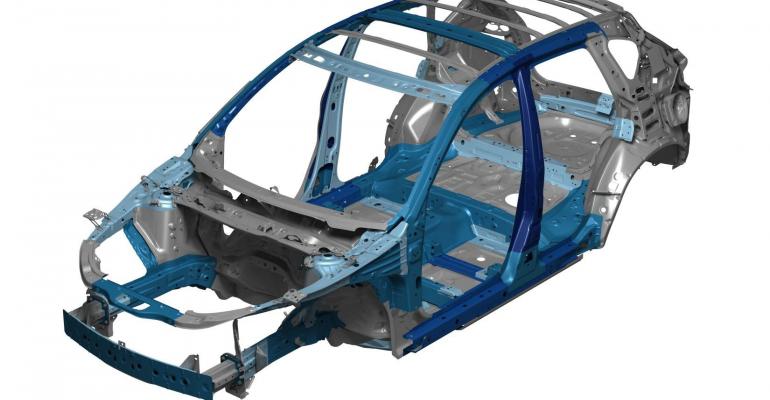LOS ANGELES – Mazda’s new CX-5 has a higher concentration of lightweight steel than any model in the brand’s North American showroom.
High-tensile-strength steel accounts for 61% of the small cross/utility vehicle’s body weight, Dave Coleman, Mazda’s product evaluation engineer, tells media here at a recent launch event.
The CX-5 also boasts what Mazda believes is the first series-production application of steel rated at 1,800 MPa (18,979 tons per sq. in.)
That grade is “the strongest steel anybody has used in a production car (and) we’re using that on the outer surface of the bumpers of this car,” Coleman says.
As a result, weight is trimmed from the extreme ends of the CX-5, thereby reducing polar movement and improving vehicle handling, he says.
In addition, sections of the CUV’s frame rails were straightened, while other parts were designed with complex shapes. The result was improved crashworthiness.
Historically, Mazda has used rectangular-shaped front frame rails, but the CX-5 features stronger, cross-shaped patterns.
“If you’ve got a rectangular frame rail, all the load is being carried in the corners of that rail,” Coleman says. “If we can fit it into this cross-shape, we end up with 12 corners instead of four corners. It doesn’t weigh any more, but we’ve got more places to carry that load.”
And by straightening the frame rails at the bottom of the CX-5, Mazda has saved weight and added strength.
Mazda frame rails long have done a “zig-zag” around a vehicle’s fuel tank. “That zig-zag is an inherently weak structure,” Coleman says. Therefore, it required more steel, which added weight.
“By just gently curving around the gas tank (with) one continuous frame rail, we can use less material to carry the same load,” Coleman says.
To better disperse crash loads, Mazda engineers extended the CX-5’s front sub-frame. Also, door beams run parallel to carry a load to the rear of the car.
The roof, B-pillar and C-pillar each boast a ring-link design for additional structural integrity.
“(We’re) just trying to connect all the structures as much as possible so it can be hit from any angle, and also these are getting us simultaneously a good structure to mount a suspension on,” Coleman says, noting suspension loads are exceeded only by crash loads as a stressor.
The CX-5 is considered all-new by Mazda, and not a successor to the defunct body-on-frame Tribute SUV, so Coleman compares the CX-5’s weight savings to the slightly bigger CX-7 CUV.
In their trimmest iterations, the CX-5 is 288 lbs. (131 kg) lighter than the CX-7. The weight difference between the heaviest CX-5 and its CX-7 counterpart is 570 lbs. (259 kg).
The new ’13 Mazda CX-5 goes on sale in the U.S. early this year, with pricing expected to range from $22,000-$28,000.




